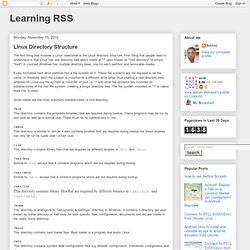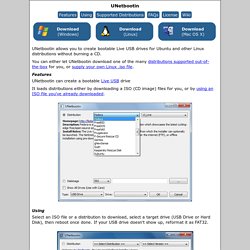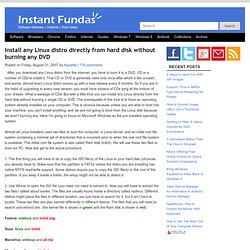

Set Nemo as Default File Manager in Ubuntu. Nemo is a file manager application developed by Linux Mint team.

It is a fork of Nautilus, the GNOME's file manager. In the beginning, Nemo was just Nautilus 3.4 (Nautilus version which is forked to become Nemo) with different name. With rapid development and improvement, Nemo now become a full-featured file manager with lots of features, more customizable, and looks beter (in my opinion) than its original (Nautilus). Chapter 1. GNU/Linux tutorials. I think learning a computer system is like learning a new foreign language.

Although tutorial books and documentation are helpful, you have to practice it yourself. In order to help you get started smoothly, I elaborate a few basic points. The powerful design of Debian GNU/Linux comes from the Unix operating system, i.e., a multiuser, multitasking operating system. You must learn to take advantage of the power of these features and similarities between Unix and GNU/Linux. Don't shy away from Unix oriented texts and don't rely solely on GNU/Linux texts, as this robs you of much useful information. Upon starting the system, you are presented with the character based login screen if you did not install X Window System with the display manager such as gdm3. Foo login: If you did install a GUI environment such as GNOME or KDE, then you can get to a login prompt by Ctrl-Alt-F1, and you can return to the GUI environment via Alt-F7 (see Section 1.1.6, “Virtual consoles” below for more). # chvt 1.
Comparison of X Window System desktop environments. A desktop environment is a collection of software designed to give functionality and a certain look and feel to an operating system.

Technical elements of a desktop environment[edit] A desktop environment (DE) can be broken up into several components that function independently and interact with one another to provide the look and feel and functionality of the desktop environment. A fundamental part of a DE is the window manager or WM. A window manager creates a certain way for application windows to present themselves to the user. It manages the various application windows, keeping track of which ones are open and providing features to switch between them. There are some exceptions: Window managers like Fluxbox, wmii and Ratpoison operate independently of a desktop environment and were written with this objective in mind.
KDE file manager Dolphin running under GNOME Notably, nothing prevents the user from installing any number of software libraries of his/her choice. Chapter 1. GNU/Linux tutorials. If You Are New to Unix. Install Nemo File Manager in Ubuntu. The upcoming changes in Nautilus 3.6 created controvery among desktop Linux users.

The latest version of the file manager application from GNOME project has been completely redesigned so that it is much simpler in term of visual design, and also in its functionality. Despite its better looking and consistency with other GNOME apps, removal of its features including compact view, tree view in sidebar, extra pane, and many other features available in its predecessor that are considered important features for many, has made users consider to find and use alternatives.
Ubuntu team has decided to stick with Nautilus 3.4 for its upcoming Ubuntu 12.10. Other Linux distro, Linux Mint team has had even more further move, by forking it, creating Nemo, a Nautilus 3.4 fork that keep its features, with some other useful addition. Nemo is a full featured file manager, like Nautilus 3.4 plus more. Nemo vs Nautilus 3.4. GNOME Shell. GNOME. GNOME (pronounced /ˈnoʊm/[5] or /ɡˈnoʊm/[6]) is a desktop environment which is composed entirely of free and open-source software and targets to be cross-platform, i.e. run on multiple operating systems, its main focus being those based on the Linux kernel.[7] GNOME is developed by The GNOME Project, which comprises both volunteers and paid contributors, the largest corporate contributor being Red Hat.[8][9] It is an international project that aims to develop software frameworks for the development of software, to program end-user applications based on these frameworks and coordinates the efforts for internationalization and localization as well as for accessibility of that software.

GNOME is part of the GNU Project[citation needed] and can be used with various Unix-like operating systems, most notably GNU/Linux. Design[edit] Overall[edit] As with most free software projects, the GNOME project is loosely managed. Comparison of X Window System desktop environments. Pastebin. Shutting down the system. Linux Directory Structure. The first thing that troubles a Linux newcomer is the Linux directory structure.

First thing that people need to understand is that Linux has one directory tree which starts at "/" (also known as "root directory" or simply "root") in contrast Windows has multiple directory trees, one for each partition and removable media. Every formatted hard drive partition has a file system on it. These file systems are not required to be the same. UNetbootin, Universal Netboot Installer / Wiki / guide. UNetbootin - Homepage and Downloads. Packages: Ubuntu Debian Fedora Suse Arch Gentoo Source Introduction UNetbootin allows you to create bootable Live USB drives for Ubuntu, Fedora, and other Linux distributions without burning a CD.

It runs on Windows, Linux, and Mac OS X. You can either let UNetbootin download one of the many distributions supported out-of-the-box for you, or supply your own Linux .iso file if you've already downloaded one or your preferred distribution isn't on the list. Requirements Microsoft Windows 2000/XP/Vista/7, or Linux, or Mac OS X 10.5+. Features UNetbootin can create a bootable Live USB drive, or it can make a "frugal install" on your local hard disk if you don't have a USB drive. The current version has built-in support for automatically downloading and loading the following distributions, though installing other distributions is also supported: UNetbootin can also be used to load various system utilities, including: » See List of Custom UNetbootin Versions and Plugins.
Installation & Screenshots. Install any Linux distro directly from hard disk without burning any DVD. After you download any Linux distro from the internet, you have to burn it to a DVD, CD or a number of CDs to install it.

That CD or DVD is generally used only once after which it lies unused , and worse, almost every Linux distro comes up with a new release every 6 months. So if you are in the habit of upgrading to every new version, you must have dozens of CDs lying at the bottom of your drawer. How to dual-boot Linux and Windows: How to run two Linux distros. There's no reason to limit yourself to just one flavour of Linux Running Linux alongside Windows isn't the only reason for dual booting.

How to dual-boot Linux and Windows: How to run two Linux distros.